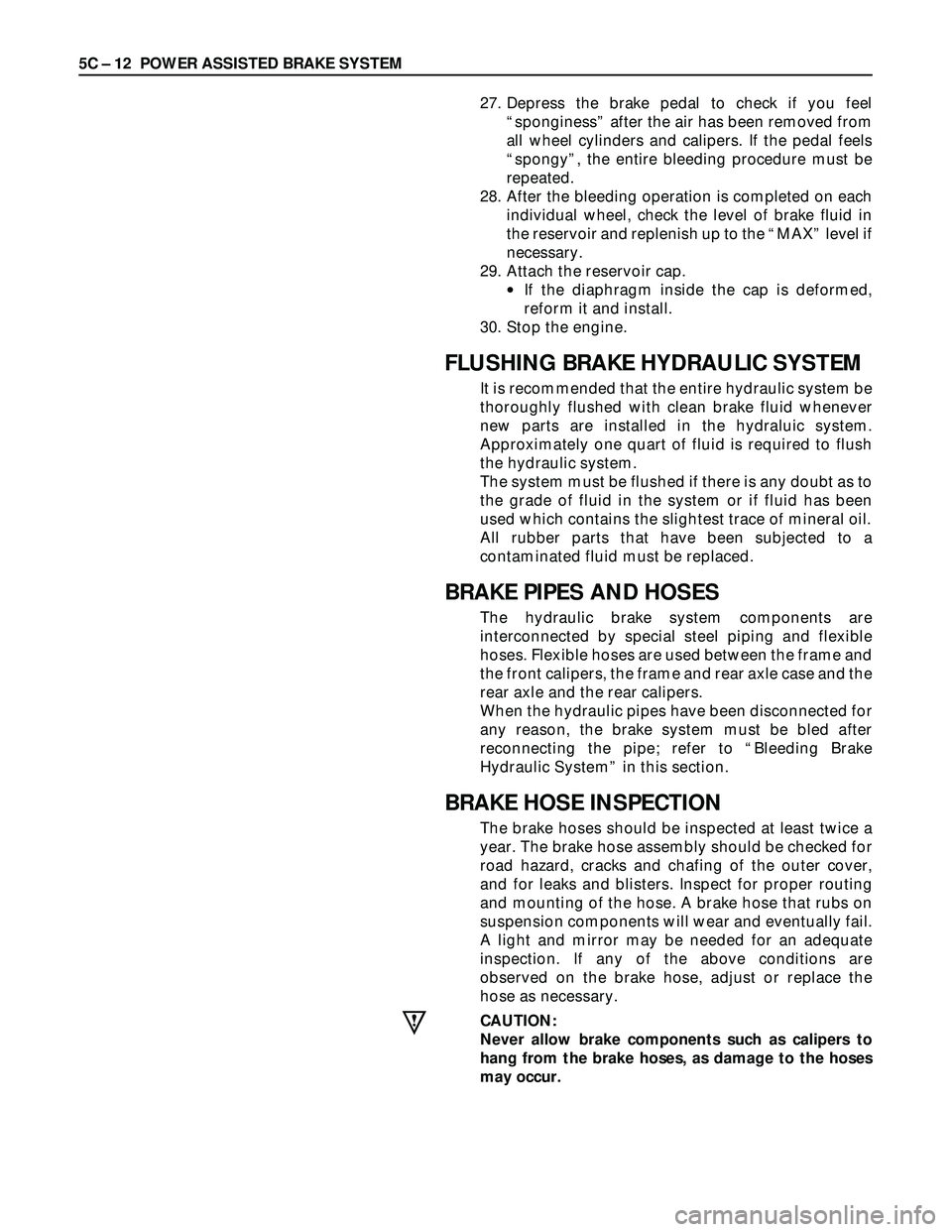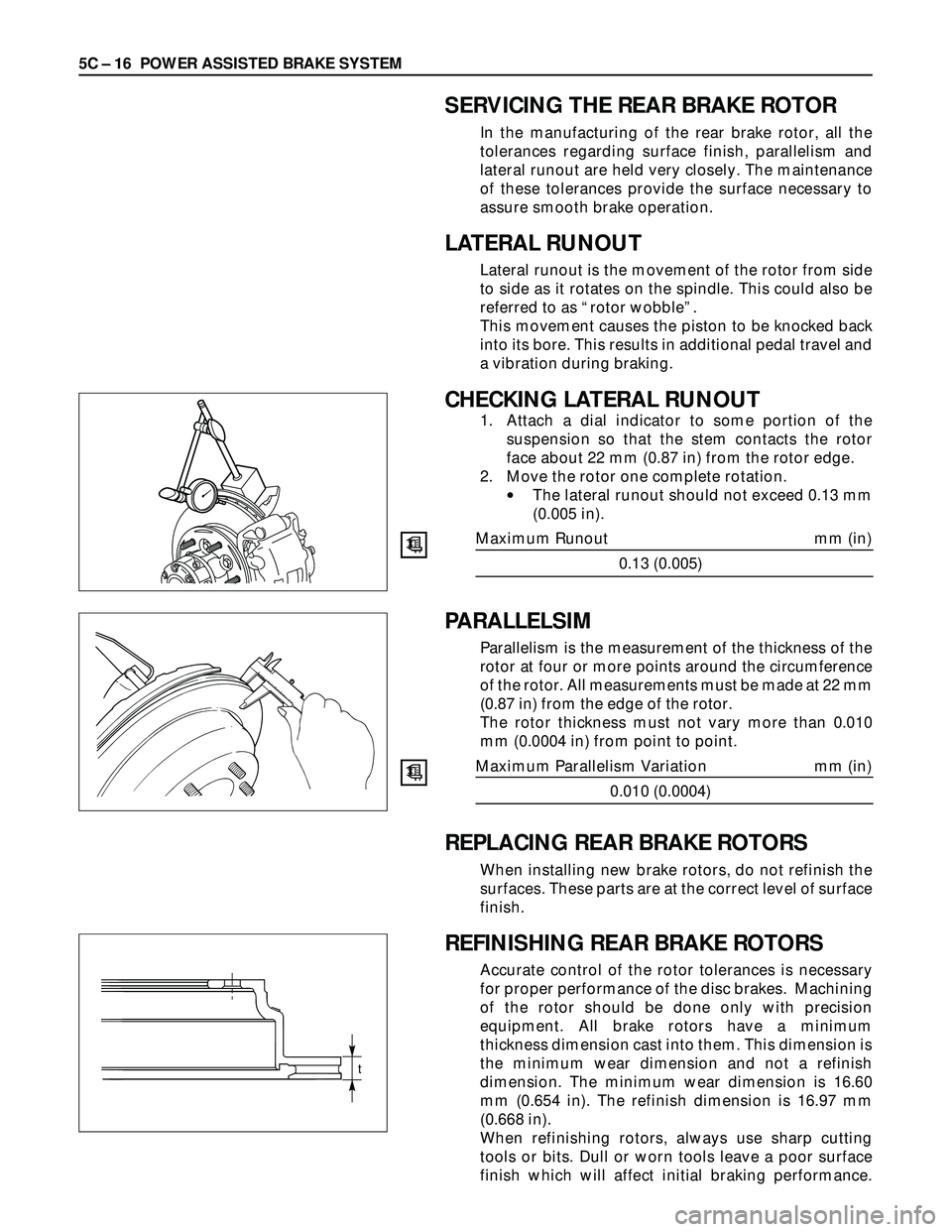Page 890 of 3573

5C – 12 POWER ASSISTED BRAKE SYSTEM
27. Depress the brake pedal to check if you feel
“sponginess” after the air has been removed from
all wheel cylinders and calipers. If the pedal feels
“spongy”, the entire bleeding procedure must be
repeated.
28. After the bleeding operation is completed on each
individual wheel, check the level of brake fluid in
the reservoir and replenish up to the “MAX” level if
necessary.
29. Attach the reservoir cap.
•If the diaphragm inside the cap is deformed,
reform it and install.
30. Stop the engine.
FLUSHING BRAKE HYDRAULIC SYSTEM
It is recommended that the entire hydraulic system be
thoroughly flushed with clean brake fluid whenever
new parts are installed in the hydraluic system.
Approximately one quart of fluid is required to flush
the hydraulic system.
The system must be flushed if there is any doubt as to
the grade of fluid in the system or if fluid has been
used which contains the slightest trace of mineral oil.
All rubber parts that have been subjected to a
contaminated fluid must be replaced.
BRAKE PIPES AND HOSES
The hydraulic brake system components are
interconnected by special steel piping and flexible
hoses. Flexible hoses are used between the frame and
the front calipers, the frame and rear axle case and the
rear axle and the rear calipers.
When the hydraulic pipes have been disconnected for
any reason, the brake system must be bled after
reconnecting the pipe; refer to “Bleeding Brake
Hydraulic System” in this section.
BRAKE HOSE INSPECTION
The brake hoses should be inspected at least twice a
year. The brake hose assembly should be checked for
road hazard, cracks and chafing of the outer cover,
and for leaks and blisters. Inspect for proper routing
and mounting of the hose. A brake hose that rubs on
suspension components will wear and eventually fail.
A light and mirror may be needed for an adequate
inspection. If any of the above conditions are
observed on the brake hose, adjust or replace the
hose as necessary.
CAUTION:
Never allow brake components such as calipers to
hang from the brake hoses, as damage to the hoses
may occur.
Page 893 of 3573

POWER ASSISTED BRAKE SYSTEM 5C – 15
CHECKING LATERAL RUNOUT
1. Adjust the wheel bearing correctly.
•Refer to Front Hub and Disc in Driveline / Axle
Section.
2. Attach a dial indicator to some portion of the
suspension so that the stem contacts the rotor
face about 29 mm (1.14 in) from the rotor edge.
3. Move the rotor one complete rotation.
•The lateral runout should not exceed 0.13 mm
(0.005 in).
Maximum Runout mm (in)
0.13 (0.005)
PARALLELISM
Parallelism is the measurement of the thickness of the
rotor at four or more points around the circumference
of the rotor. All measurement must be made at 29 mm
(1.14 in) from the edge of the rotor.
The rotor thickness must not vary more than 0.010
mm (0.004 in) from point to point.
Maximum Parallelism mm (in)
0.010 (0.0004)
REPLACING FRONT BRAKE ROTORS
When installing new brake rotors, do not refinish the
surfaces. These parts are at the correct level of surface
finish.
REFINISHING FRONT BRAKE ROTORS
Accurate control of the rotor tolerances is necessary
for proper performance of the disc brakes. Machining
of the rotor should be done only with precision
equipment. All brake rotors have a minimum
thickness dimension cast into them. This dimension is
the minimum wear dimension and not a refinish
dimension. The minimum wear dimension is 24.60
mm (0.969 in). The minimum refinish dimension is
24.97 mm (0.983 in).
When refinishing rotors, always use sharp cutting
tools or bits. Dull or worn tools leave a poor surface
finish which will affect initial braking performance.
Vibration dampening attachments should always be
used when refinishing braking surfaces. These
attachments eliminate tool chatter and will result in
better surface finish.
After refinishing, replace any rotor that does not meet
the minimum thickness of 24.97 mm (0.983 in). Do not
use a brake rotor that will not meet the specification.
Minimum Wear Dimension mm (in)
24.60 (0.969)
Refinish Dimension mm (in)
24.97 (0.983)
t
Page 894 of 3573

5C – 16 POWER ASSISTED BRAKE SYSTEM
PARALLELSIM
Parallelism is the measurement of the thickness of the
rotor at four or more points around the circumference
of the rotor. All measurements must be made at 22 mm
(0.87 in) from the edge of the rotor.
The rotor thickness must not vary more than 0.010
mm (0.0004 in) from point to point.
Maximum Parallelism Variation mm (in)
0.010 (0.0004)
REPLACING REAR BRAKE ROTORS
When installing new brake rotors, do not refinish the
surfaces. These parts are at the correct level of surface
finish.
REFINISHING REAR BRAKE ROTORS
Accurate control of the rotor tolerances is necessary
for proper performance of the disc brakes. Machining
of the rotor should be done only with precision
equipment. All brake rotors have a minimum
thickness dimension cast into them. This dimension is
the minimum wear dimension and not a refinish
dimension. The minimum wear dimension is 16.60
mm (0.654 in). The refinish dimension is 16.97 mm
(0.668 in).
When refinishing rotors, always use sharp cutting
tools or bits. Dull or worn tools leave a poor surface
finish which will affect initial braking performance.
SERVICING THE REAR BRAKE ROTOR
In the manufacturing of the rear brake rotor, all the
tolerances regarding surface finish, parallelism and
lateral runout are held very closely. The maintenance
of these tolerances provide the surface necessary to
assure smooth brake operation.
LATERAL RUNOUT
Lateral runout is the movement of the rotor from side
to side as it rotates on the spindle. This could also be
referred to as “rotor wobble”.
This movement causes the piston to be knocked back
into its bore. This results in additional pedal travel and
a vibration during braking.
CHECKING LATERAL RUNOUT
1. Attach a dial indicator to some portion of the
suspension so that the stem contacts the rotor
face about 22 mm (0.87 in) from the rotor edge.
2. Move the rotor one complete rotation.
•The lateral runout should not exceed 0.13 mm
(0.005 in).
Maximum Runout mm (in)
0.13 (0.005)
t
Page 925 of 3573
POWER ASSISTED BRAKE SYSTEM 5C – 47
FRONT DISC BRAKE
BRAKE PADS REPLACEMENT
Outer side1
2
3
45
5
Removal Steps
1. Wheel and tire assembly
2. Lock bolt
3. Caliper assembly
4. Pad assembly with shim
5. Clip
Installation Steps
To install, follow the removal steps in the
reverse order.
REMOVAL
NOTE:
If a squealing noise occurs from the front brake while
driving, check the pad wear indicator plate. If the
indicator plate contacts the rotor, the disc pad
assembly should be replaced.
Preparation:
1) Draw out two-thirds of the brake fluid from the
reservoir.
2) Raise the vehicle and support it with suitable
safety stands.
1. Wheel and Tire Assembly
•Refer to Wheels and Tires in Suspension section.
Page 927 of 3573
POWER ASSISTED BRAKE SYSTEM 5C – 49
3. Caliper Assembly
1) Use adjustable pliers to bottom the piston into the
caliper bore. Be careful not to damage the piston
dust boot.
2) Do not damage the flexible hose by twisting or
pulling it.
2. Lock Bolt
Lock Bolt Torque N·m (kg·m / lb·ft)
74 (7.5 / 54)
1. Wheel and Tire Assembly
1) Refer to Wheels and Tires in Suspension section.
2) Pump the brake pedal several times to make sure
that the pedal is firm. Check the brake fluid level
in the reservoir after pumping the brakes.
Page 928 of 3573
5C – 50 POWER ASSISTED BRAKE SYSTEM
REMOVAL
Raise the vehicle and support with suitable safety
stands
1. Wheel and Tire Assembly
•Refer to Wheels and Tires in Suspension section.
2. Brake Flexible Hose
1) Remove the bolt and gaskets, then disconnect the
flexible hose from the caliper.
2) After disconnecting the flexible hose, cap or tape
the openings to prevent entry of foreign material.
3) Since the brake fluid flows out from the
connecting coupler, place a drain pan under the
vehicle.
CALIPER REPLACEMENT
Outer side
4
3
2
758
8
6
1
Removal Steps
1. Wheel and tire assembly
2. Brake flexible hose
3. Guide bolt
4. Lock bolt
5. Caliper assembly
6. Support bracket with pad assembly
7. Pad assembly with shim
8. Clip
Installation Steps
To install, follow the removal steps in the
reverse order.
Page 930 of 3573
5C – 52 POWER ASSISTED BRAKE SYSTEM
5. Caliper Assembly
4, 3. Lock Bolt and Guide Bolt
Lock Bolt and Guide Bolt Torque N·m (kg·m / lb·ft)
74 (7.5 / 54)
2. Brake Flexible Hose
1) Always use new gaskets.
2) Be sure to put the hooked edge of the flexible
hose end into the anti-rotation cavity.
Brake Flexible Hose Torque N·m (kg·m / lb·ft)
35 (3.5 / 26)
1. Wheel and Tire Assembly
1) Refer to Wheels and Tires in Suspension section.
2) Bleed brakes. Refer to Bleeding Brake Hydraulic
System in this section.
Hooked edge
Gasket
Page 934 of 3573
5C – 56 POWER ASSISTED BRAKE SYSTEM
REAR DISC BRAKE
BRAKE PADS REPLACEMENT
1
5
5
3
2
4
Removal Steps
1. Wheel and tire assembly
2. Lock bolt
3. Caliper assembly
4. Pad assembly with shim
5. Clip
Installation Steps
To install, follow the removal steps in the
reverse order.
REMOVAL
NOTE:
If a squealing noise occurs from the rear brake while
driving, check the pad wear indicator plate. If the
indicator plate contacts the rotor, the disc pad
assembly should be replaced.
1) Draw out two-thirds of the brake fluid from the
reservoir.
2) Raise the vehicle and support it with suitable
safety stands.
1. Wheel and Tire Assembly
•Refer to Wheels and Tires in Suspension section.
2. Lock Bolt